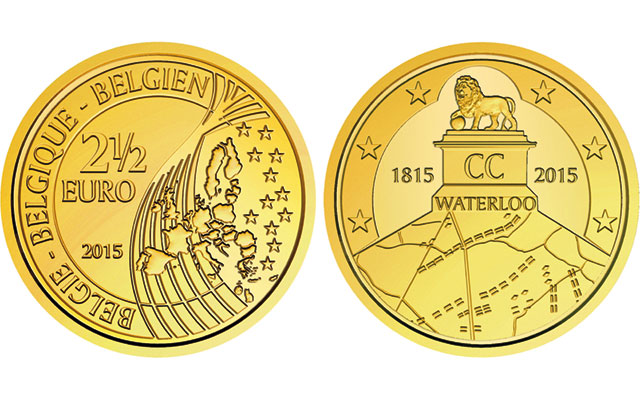When Belgium Flipped the Coin at France

Pictured above is the French version of the 2 euro coin. On the obverse side — “heads” in coin-flipping parlance — is a France-specific design. There’s a tree, symbolizing life, set upon a hexagon because France is kind of hexagonally shaped. The letters “RF” stand for “République française,” and the nation’s motto — “liberté, égalité, fraternité” — encircle the hexagon. The coin, while clearly French, is also clearly a euro, as seen on the reverse side. And it is legal tender outside of France; like all other euro coins, it can be used in any of the 26 nations and territories that use the euro as its official currency.
And France isn’t unique in its ability to coin its own euros, with its own designs. Each of the member states of the EU (and other members of the euro-sharing monetary agreement) have their own designs for their own coins, in part to help further a sense of national pride. And to the delight of coin collectors everywhere, the euro agreement allows member nations can also issue commemorative coins that are legal tender throughout the eurozone — and most nations regularly do.
But national pride doesn’t always comport with regional interests. While Europe’s nations have been mostly at peace over the last quarter-century, that wasn’t always the case. There’s the Cold War, World War II, World War I, all sorts of revolutions, the Napoleonic Wars, the Franco-Dutch War, the 30 Years’ War, etc., etc. — here’s a very, very long list. One nation’s victory is another’s defeat and probably wouldn’t make for a good all-region coin design.
Belgium, though, didn’t seem to care. In 2015, the nation decided to honor the 200th anniversary of the Battle of Waterloo, the site of Napoleon’s final defeat. Waterloo is located in modern-day Belgium and Belgium, which didn’t even exist two centuries ago, isn’t very concerned with the issues and politics of a war long over. The nation wanted to commemorate the major battle that took place within its borders, so they created a commemorative 2 euro coin, minting 180,000 of the keepsake currency. As Belgian finance minister Johan Van Overtveldt told the Agence France-Presse (via the New York Times), “the goal is not to revive old quarrels in a modern Europe — and there are more important things to sort out. But there’s been no battle in recent history as important as Waterloo, or indeed one that captures the imagination in the same way.”
France, however, disagreed. As the Guardian reported, France sent Belgium a letter saying that the coins “could cause an ‘unfavorable reaction in France.'” And apparently, member nations can stop other member nations from minting and distributing coins that could cause such unfavorable reactions. France demanded that Belgium not only stop minting the coin but also that it destroy the 180,000 already minted. Belgium, while not happy with the demand, didn’t have much of a choice — the rules, after all, are the rules.
And then there are the loopholes, as seen below.

That’s a euro coin and as you can see, it very clearly has the word “Waterloo” on one of the sides. But as you probably also noticed, it’s not a 2 euro coin — it’s a 2 1⁄2 euro coin. That’s not an accident. Euro coins come in denominations of 1, 2, 5, 10, 20, and 50 cents, as well as in 1 and 2 euro form. There isn’t regularly a 2 1⁄2 euro coin. As the New York Times explained, “Belgium decided to circumvent French resistance [heh] by invoking a little-known European Union rule that allows countries to issue euro coins of their choice, provided they are in an irregular denomination.”
France was powerless to stop the Belgian incursion into their sensibilities, and Belgium ultimately minted 70,000 of the coins above. But the matter wasn’t a total loss for the offended French. Because 2 1⁄2 isn’t a standard euro coin denomination, the coin isn’t legal tender outside of Belgium (and certainly not in France). And in any event, the coin was made available mostly as a collectible — per the Guardian, if you wanted one, they were originally “sold in special plastic bags priced at €6,” more than twice their face value. Today, they often sell for closer to €25.
Bonus fact: Waterloo Bridge in London is named for the Battle of Waterloo, and therefore, so is London’s Waterloo train station (which gets its name from the bridge). And this provided Winston Churchill with an opportunity — unrealized, unfortunately — to make a last joke at the expense of his French counterpart, even in death. More than a dozen years before he died, Churchill created a plan (titled “Operation Hope Not“) that outlined the details of his funeral wishes. As the Slightly Foxed podcast notes, the plan spelled out that Churchill “wanted the train bearing his coffin to depart from Waterloo rather than Paddington (which would have been the more logical departure point for a train bound for Bladon in Oxfordshire, where he was to be buried).” The reason? To get a great picture of Charles de Gaulle. Slightly Foxed continues: “The French President would thus be forced to walk bare-headed beneath the station’s archway which celebrates the great victory over Napoleon.”
From the Archives: The Statue in Glasgow with a Traffic Cone on Its Head — Sometimes: It honors the guy who beat Napoleon at Waterloo. The statue, not the traffic cone, that is.
